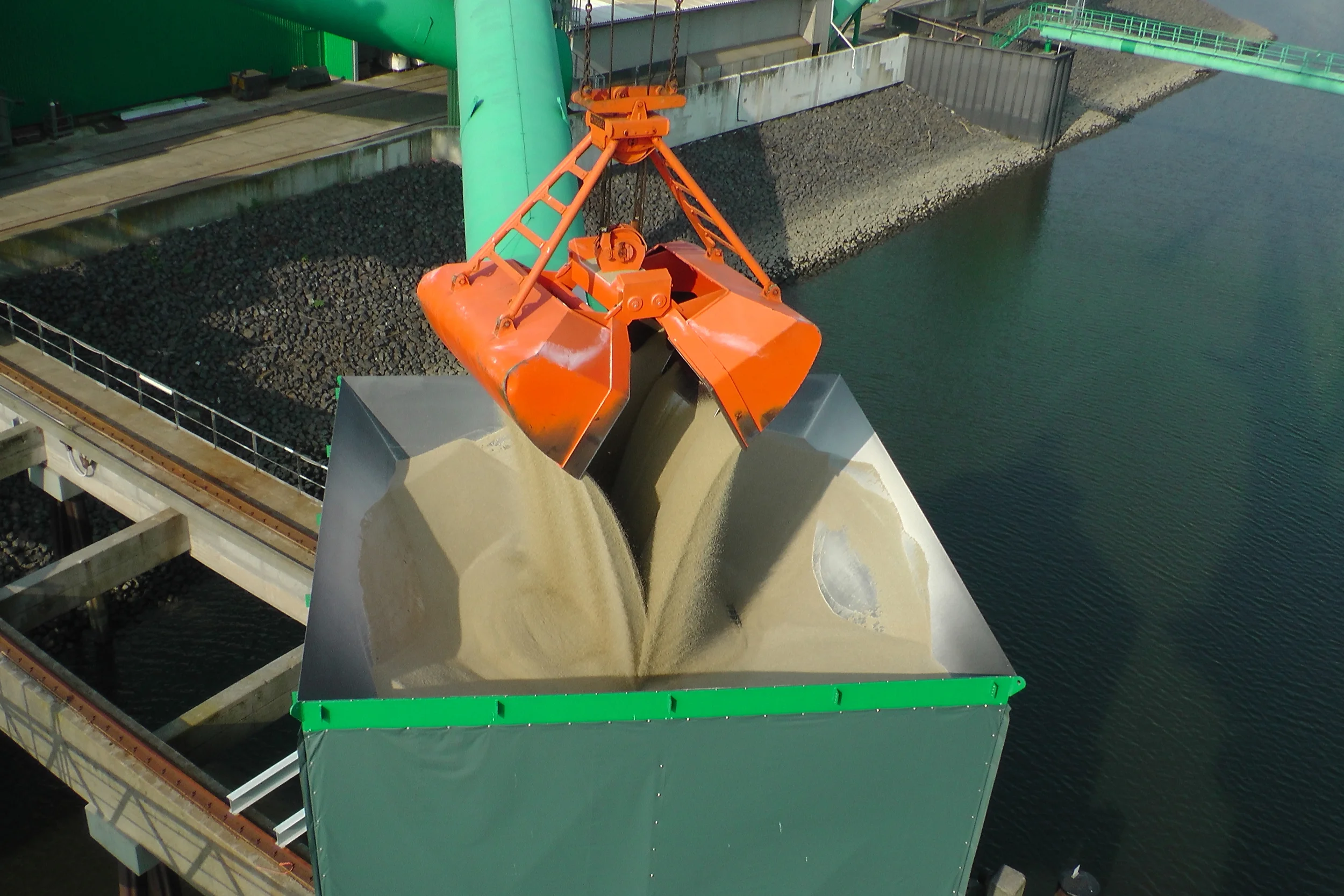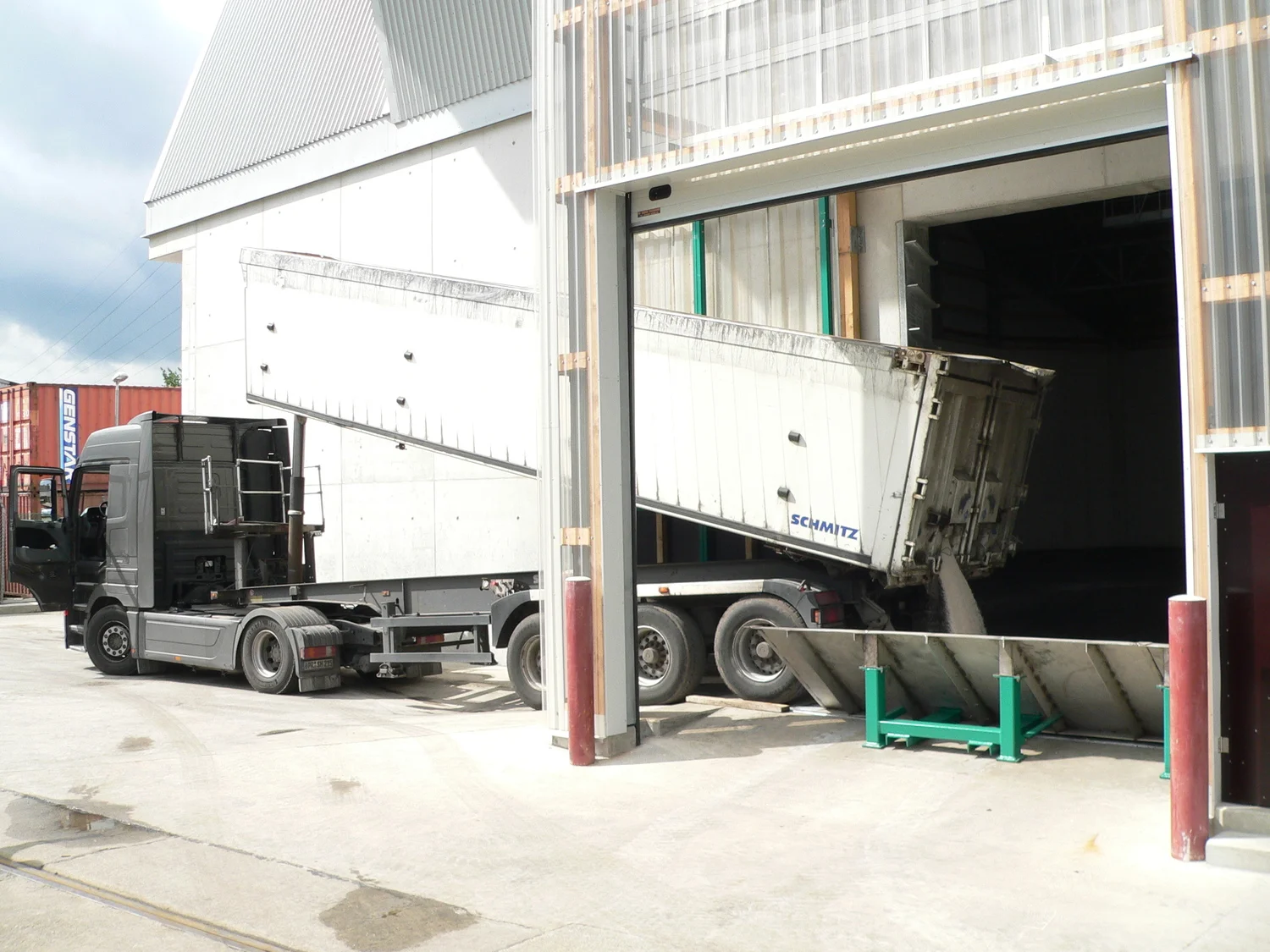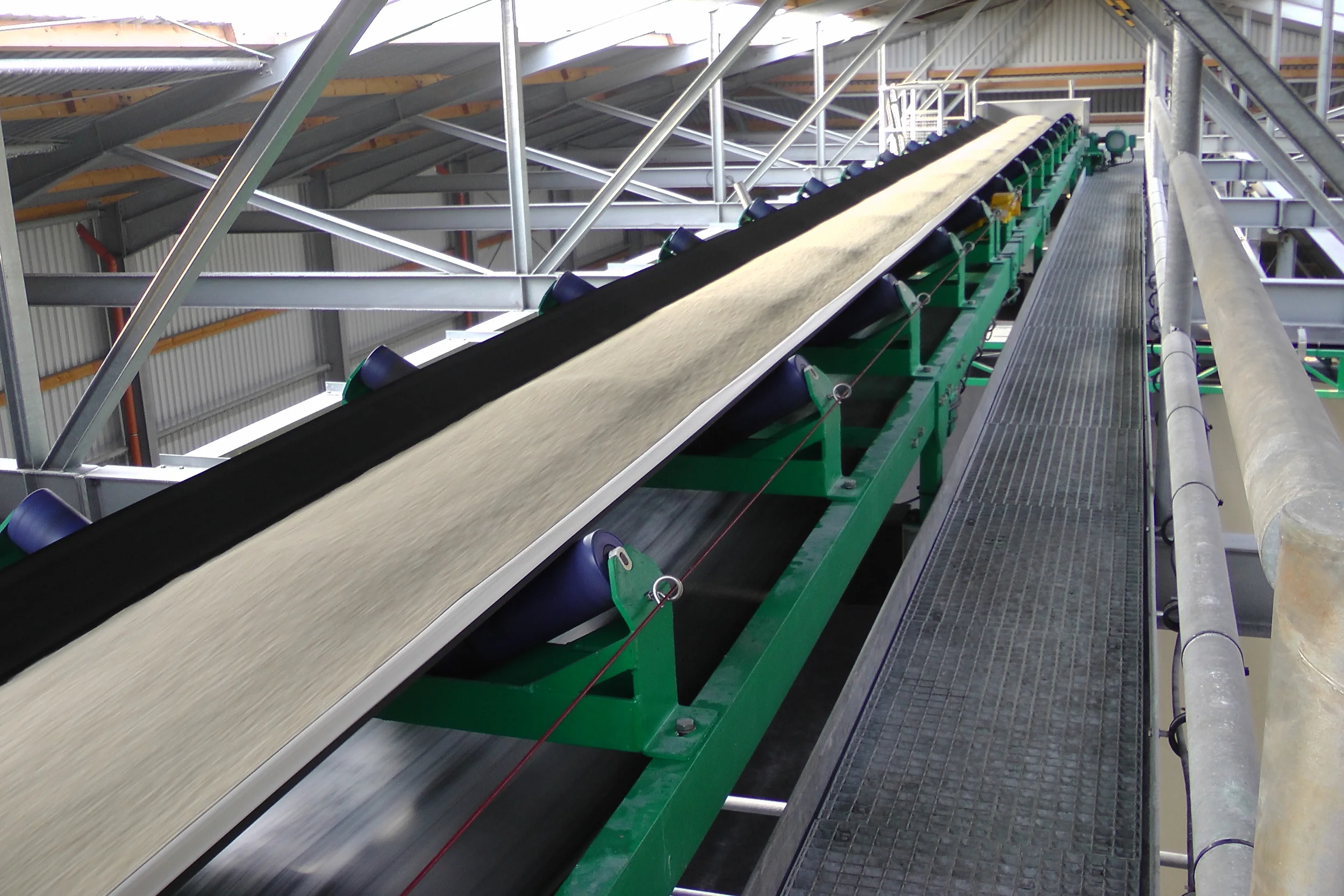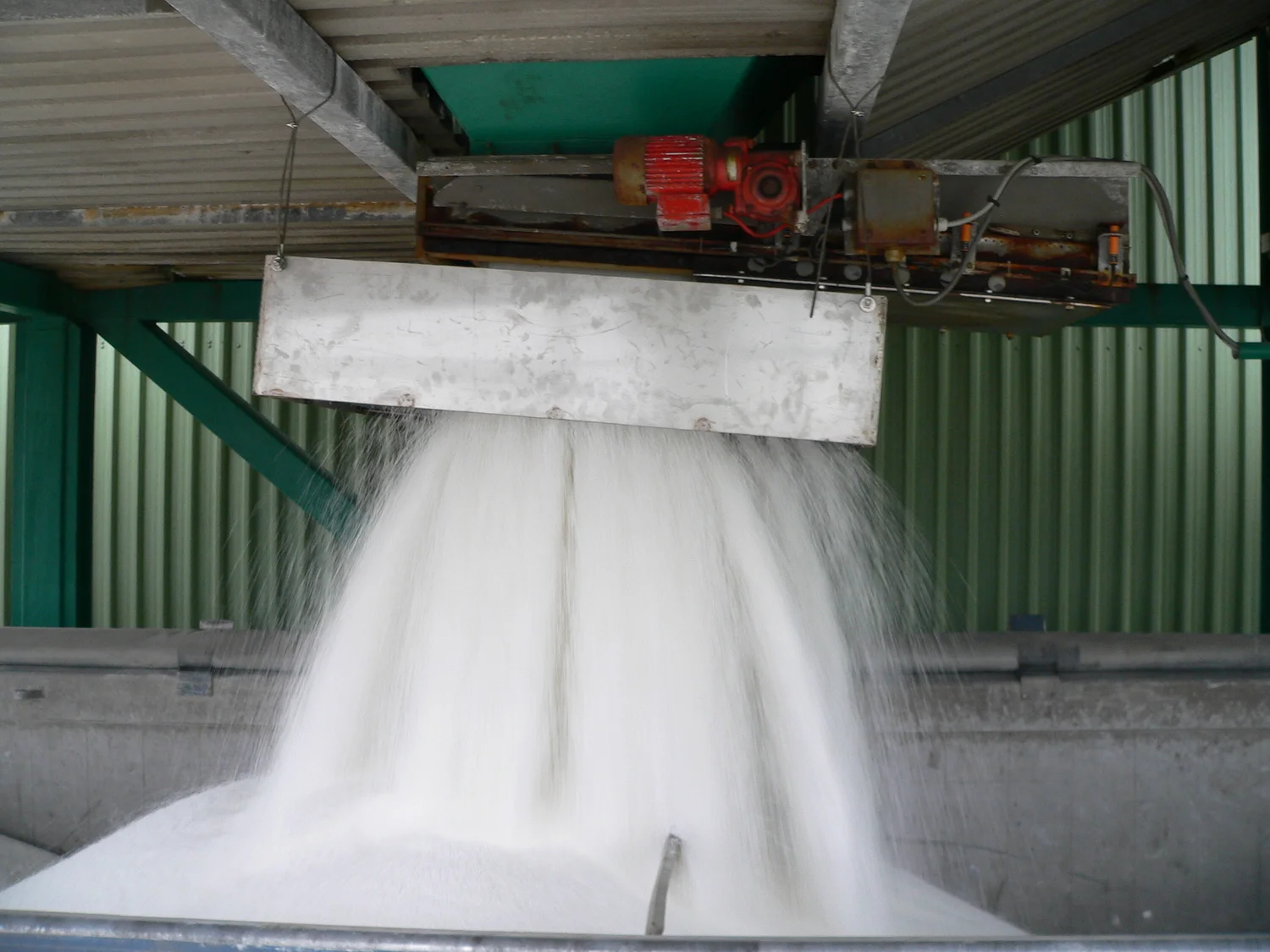









Stevedoring in the Port of Hamburg
Your reliable partner for dry bulk handling
in the port of Hamburg since 1878
Stevedoring in the Port of Hamburg
Your reliable partner for dry bulk handling
in the port of Hamburg since 1878
Welcome at Louis Hagel in the Port of Hamburg
As one of the oldest operations in the Port of Hamburg, Louis Hagel complements its extensive experience in the handling of bulk goods and general cargo by offering state-of-the-art transloading technology and warehousing for dry bulk goods. We are your specialist for loading and unloading ships as well as your reliable partner for loading goods on trucks or railway-cars.
We look forward to hearing from you or your inquiries at any time!

Loading ships
via bulk loader or grab crane
Loading ships
via bulk loader or grab crane
Loading ships and barges
Our dry bulk loader guarantees quick loading of ships up to 30.000t – clean and reliable. Get to know the various application possibilities of our state-of-the art double jib level luffing crane.
The Louis Hagel complex does not have a quay wall. Therefore the loader is not fixed in the water but situated on a specially constructed floating pontoon, where it can be moved over a length of 104m.
Key facts for ship loading with bulk loader:
Transloading
a) Direct transloading ex freight car/truck
b) Transloading ex Silo 1 & 2
c) Transloading ex Silo 3
Products
Free-flowing bulk goods
(e.g., fertilizer, salt)
Capacity
a) ca. 400-500t/h
b) ca. 500-750t/h
c) ca. 250t/h
Weighing
a) Carriage weight
b) Calibrated belt scale
c) Calibrated scale
Key facts for ship loading with 12t grab crane:
Transloading
a) Ship-to-ship transloading
b) Ship-to-ship transloading
Products
a) Dry bulk goods
b) General cargo
Capacity
a) ca. 300t/h
b) n.n.
Weighing
a) Ship calibration
b) Ship calibration

Discharging ships
via 12t grab crane
Discharging ships
via 12t grab crane
Discharging ships
Our grab crane mooring at Hagel-South has a constant water depth of 11m (Chart Datum) for seagoing vessels. Additionally barges with a width of 11m and a length of 100m can moor parallel to a seagoing vessel below our free-standing crane platform.
Therefore, incoming goods can be transloaded ship-to-ship onto seagoing vessels or barges, loaded onto lorries or carriages, or stored in one of our Silos.
Transloading onto trucks, freight cars or container
For this type of transloading, goods are removed by our 12t grab crane using a hopper at the height of the crane platform, and it involves a low drop height. When rain sets in, the hopper can be easily and quickly closed with an existing electric roof lock via a remote control to protect sensitive goods. The goods are carefully transported via a closed conveyor belt system on land. The goods are then transported to two hopper truck loading station with scales which enables efficient loading of trucks etc.
Ship-to-ship loading
Incoming goods can be fully or partially loaded, ex seagoing vessel to barges or ex barges to a seagoing vessel, based on the type of ship to be discharged.
Storage of dry bulk goods
Imported batch quantities not accepted as part of direct transhipment, as well as entire shiploads, can be stored in silos 1, 2 and 3 A+B subsequently re-loaded onto trucks or ships etc..
Optional breaking and sieving of problematic products possible
If necessary, problematic goods can first be broken with the aid of two separate crushers and, before being loaded onto trucks or wagons, sieved with the aid of two vibrating sieving machines in order to be able to exclude complaints from the consignee.
Key facts for ship discharging with grab crane ex vessel:
Transloading
a) Onto trucks, freight cars or container
b) Storage in silos 1, 2 and 3 A+B
c) Ship-to-ship
d) Ship-to-ship
Products
a) Dry bulk goods
b) Dry bulk goods
c) Dry bulk goods
d) General cargo
Capacity
a) ca. 400-500t/h
b) n.n
c) ca. 400-500t/h
d) n.n
Weighing
a) Calibrated scale
b) Ship calibration
c) Ship calibration
d) Ship calibration

Storage
We offer a wide range of storage facilities
Storage
We offer a wide range of storage facilities
Silo 1 for storage of dry bulk cargo
The dry bulk goods Silo 1 was built in 1998 and offers the possibility to store 18.000 tons in total.
Two dividing walls separate the warehouse space into three sections, enabling the simultaneous storage of three different goods. While the warehouse space reaches a height of 24m on one longitudinal side, the height on the other longitudinal side is only 7m. This unusual form results in a 28° slope of the roof, which matches the angle of repose of fertlizer.
Goods are delivered via rail, seagoing vessels or barges; limited quantities can also be delivered by trucks. Irrespective of the delivery method, the goods arrive in the warehouse via closed conveyer belts. The product is not thrown from the ceiling onto the floor, as it is usual in most cases, but is handled much more gently by an innovation: The storage as well as the outsourcing takes place with a specially developed scraper, whereby the scraper fulfill a double function ,during storage, the goods are transported by the scraper blades from bottom to top. This eliminates a free fall of the goods and reduces possible dust to a minimum. In addition, this also prevents the formation of dust cones or segregation of the valuable goods. When outsourcing, the scraper blades scratch the goods again from top to bottom on the conveyor belt system.
Removal by trucks or ships
Goods are either removed onto seagoing vessels or barges with our bulk loader or brought to the street using the truck loading station. For ship loading, the weighing is carried out using a calibrated belt scale and the cargo arrives on the ship via the telescopic tube of the loader. For storage and removal, the transloading capacity is ca. 800 t/h.
Silo 2 for storage of dry bulk cargo
Our second storage silo for bulk goods was also built in 1998 and connected to our silo 1 through extensive renovations at the beginning of 2021. The silo has a storage capacity of approx. 5,000 t and also enables single-type storage.
Silos 3 A+B for storage of dry bulk cargo
Our most recent built silos 3 A+B for the storage of dry bulk cargo were launched in 2012. The Concrete Silo consists of two identical boxes, each offering the possibility to store up to 9,000 tonnes of fertilizer and other dry bulk goods.
The supply of cargo into the silo takes place from the water side with the grab crane to the conveyor belt system, or shoreside by truck into two underground bunkers.
The goods are removed from the storage by a wheel loader and loaded weighed onto trucks or railway cars. We guarantee an environmental friendly handling of all suitable bulk cargoes. Our company is primarily focused on the handling of high-quality products (e.g. fertilizers), which require a particularly careful handling. The needs of our customers is always at the focus of our actions.

Loading of trucks and railway cars
Weather independent loading
Loading of trucks and railway cars
Weather independent loading
1) Loading trucks at Hopper-North
At Hopper-North, dry bulk goods can be loaded ex vessels, freight cars or from the company’s Silo 1. The weight determination of the goods to be loaded is carried out by a calibrated scale by means of full and empty weighing the hopper.
Key facts for Hopper-North (calibrated hopper scale):
Transloading
a) Direct ex freight cars/vessels/containers
b) Indirect ex Silo 1
Products
Dry and free-flowing bulk
goods (e.g., fertilizer, salt)
Capacity
a) ca. 250t/h
b) ca. 450t/h
Weighing
a) Calibrated hopper scale
a) Calibrated hopper scale
2) Loading trucks & freight cars at Hopper-South-Landside
At our Hopper-South-Landside dry bulk goods ex vessels or from our Silos 3 A+B can be continuously loaded to trucks or freight cars. If necessary, a vibrating screen can be connected to the lumpy goods before loading into the truck or railway car, so that the recipient arrives exclusively free-flowing and lump-free goods.
Key facts for Hopper-South
Transloading
a) Direct ex vessel
b) Indirect ex Silo 3 A+B
Products
Dry and free-flowing bulk
goods (e.g., fertilizer, salt)
Capacity
a) ca. 250t/h
b) ca. 250t/h
Weighing
a) Calibrated weighing scale
b) Calibrated weighing scale
3) Loading trucks at Hopper-South-Water-Waterside
At Hopper-North-Waterside, dry bulk goods can be loaded ex vessels or from our Silo 3 A+B. The weight determination of the goods to be loaded is carried out by a calibrated scale by means of full and empty weighing the hopper. If necessary, a vibrating screen can be connected to the lumpy goods before loading into the trucks or railway cars, so that the recipient arrives exclusively free-flowing and lump-free goods.
Key facts for Hopper-South-Waterside (calibrated hopper scale):
Transloading
a) Direct ex vessel
b) Indirect ex Silo 3 A+B
Products
Dry and free-flowing bulk
goods (e.g., fertilizer, salt)
Capacity
a) ca. 250t/h
b) ca. 250t/h
Weighing
a) Calibrated hopper scale
b) Calibrated hopper scale

Container loading
Weather independent loading of 20" container
Container loading
Weather independent loading of 20" container
Loading of 20" container
We offer the possibility to load 20" containers. Dry and free-flowing goods can be loaded onto the containers ex vessels, railway cars, trucks, our storage or transloaded from damaged containers. The facility is rain-proof.
Key facts for container loading (calibrated hopper scale):
Transloading
a) Direct ex freight cars/vessels/trucks
b) Indirect ex storage Silo 1 + 3
Products
Dry and free-flowing bulk
goods (e.g., fertilizer, salt)
Capacity
a) ca. 85t/h
b) ca. 85t/h
Weighing
a) Calibrated hopper scale
b) Calibrated hopper scale

History
147 years of Louis Hagel GmbH & Co. KG in 2025
History
147 years of Louis Hagel GmbH & Co. KG in 2025
On October, 10th in 1878, freight forwarder Louis Hagel Senior founded the Louis Hagel company in Hamburg-Harburg on the Elbe River.
The company, which started solely as a transport company, was soon expanded to include a furniture transport line. In 1910, the company began transloading and storing loose and bagged bulk goods in the inland port of Hamburg. As early as the 1920s, 100 railway cars were being loaded every day in shift operation. At the time, the company already had substantial capacities at its disposal: numerous stables und furniture warehouses, around 60 horses, a fleet of 90 dollies, trucks and tractors, ten electrical cranes, 6,500m² of covered storage area and two office buildings.
The company’s successful development was interrupted by the outbreak of World War II: The then owner and Managing Director, Louis Hagel, son of the founder, lost his life in 1943.
The buildings and warehouses were completely destroyed, and the vehicle fleet and cranes suffered heavy damage. Although rebuilding efforts after the war proved difficult, seven of the ten cranes could be put back into operation as early as 1946. During this period, business activities focused on the loading of chartered trains for flour, grain and potatoes.
In 1969 Joachim Ludwig Hagel arranged the relocation for the company headquarters moving from the Hamburg inland port to the Southern Reiherstieg. A new grab crane and bulk loader were put into operation in conjunction with the move.
Since 1987, the company has been managed by Horst Hagel as the third generation member together with his wife Gisela Hagel. In 1993, he commissioned the construction of a modern bulk loader and, in 1998, was responsible for the most comprehensive investment in the history of the company: the construction of a large warehouse and expansion of the bulk loader.
Louis Hagel is a “true family business”: Horst Hagel, his wife Gisela, and their children Sandra Reidock, Catharina Kunz as well as grandson Julian Reidock as a fith generation family member are all active in the company.

Location
in the center of the Port of Hamburg
Location
in the center of the Port of Hamburg
Louis Hagel GmbH & Co. KG is located on the Southern Reiherstieg. The motorways A1 (via the Stillhorn junction) and A7 (via the Moorburg or Waltershof junctions) can be reached within a few minutes. The Hamburg city centre is only a 15-minute drive via the A253 and Wilhelmsburger Reichsstraße.
Two company-owned tracks (531 feeder tracks) are connected to the Deutsche Bahn railway network.

Contact
We look forward to receiving your call
Contact
We look forward to receiving your call
Address:
Louis Hagel GmbH & Co. KG
Eversween 19
D-21107 Hamburg
GERMANY
Communication details:
Telephone: +49-40-751651
Terminal: +49-40-751653
Business hours: mo.-fr.: 08:00 h – 16:30 h
Terminal hours: mo.-fr.: 07:00 h – 15:30 h



























































The berth on our bulk loader (Hagel-North) has a constant water depth of 11m (Chart Datum). This enables the loading of seagoing vessels with a length up to 200m and a width of 28m.